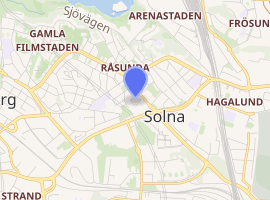Råsunda Stadium
Råsunda Stadium (Swedish: [ˈrôːˌsɵnːda] (![]()
 Råsunda Stadium during demolition in February 2013 | |

| |
| Full name | Råsunda Fotbollsstadion |
|---|---|
| Location | Solna Municipality, Stockholms län, Sweden |
| Coordinates | |
| Owner | Swedish Football Association |
| Capacity | 36,608[1] |
| Record attendance | 52,943 |
| Field size | 105 x 68 m |
| Construction | |
| Built | ?–1937 |
| Opened | 17 May 1937 |
| Renovated | 1985 |
| Expanded | 1958 |
| Closed | 2012 |
| Demolished | 2013 |
| Architect | Birger Borgström Sven Ivar Lind |
| Tenants | |
| Sweden national football team (1937–2012) AIK (1937–2012) Djurgårdens IF (1989–90, 2004) | |
History
It was opened in 1937 although there had already existed stadiums at the site; the earliest opened in 1910. The inaugural match took place on 18 April 1937 when AIK played against Malmö FF, AIK won the match 4–0.[2] Råsunda has a capacity of 35,000–36,608 depending on usage.[3] The 1910 stadium hosted some of the football and some of the shooting events at the 1912 Summer Olympics.[4] The stadium was the home stadium for AIK, and was used for many derbies between Stockholm clubs. It also hosted the headquarters of the Swedish Football Association, and staged 75% of the home matches of the national football team each year, with most other matches being played at Ullevi in Gothenburg. These two stadiums are UEFA 4-star rated football stadiums.
The record attendance was 52,943 and was set on 26 September 1965, when Sweden played West Germany. West Germany won the match 2-1.
The last major concert held at the stadium was on 7 June 1986, when British rock band Queen kicked off their final tour, The Magic Tour, at Råsunda. That night Queen played to about 37,500 fans.
Råsunda was the first of two stadiums to have hosted the World Cup finals for both men and women. It hosted the men's final in the 1958 World Cup and the women's final in the 1995 Women's World Cup. The other stadium with this honor is the Rose Bowl in Pasadena, California, USA (men in 1994 World Cup, women in 1999 Women's World Cup).
On 1 April 2006, the Swedish Football Association announced a plan to switch to a new stadium to be built in Solna. The new arena was completed and ready for sporting events in 2012, and the Råsunda Stadium will be subsequently demolished. The new stadium has a capacity for 50,000 spectators. The name of the new arena is Friends Arena. Swedbank bought the name for 150 million SEK but decided to name it in support of the non profit organization Friends in 2012.[5]
The last event held at the Råsunda Stadium was the Europa League's match AIK - S.S.C. Napoli, played on 22 November 2012, finished 1-2. Edinson Cavani scored the last goal which closed the glorious history of the stadium.
Fabege AB and Peab AB signed an agreement to acquire Råsunda Football Stadium and existing office buildings from the Swedish Football Association on 11 December 2009. All activities on the arena remained until Friends Arena stood finished.[6]
References
- https://www.uefa.com/MultimediaFiles/Download/FirstDiv/uefaorg/Publications/01/67/03/93/1670393_DOWNLOAD.pdf
- aftonbladet.se
- www.aik.se Archived 2007-06-23 at the Wayback Machine
- 1912 Summer Olympics official report. pp. 221-3.
- New National Arena In Solna
- "Fabege - press release". Cision Wire. Archived from the original on 2013-01-19. Retrieved 2009-12-11.
http://www.fastighetssverige.se/artikel/sa-har-blir-nya-rasunda-10654/
External links
![]()
| Preceded by 4 venues (Wankdorf Stadium, Charmilles Stadium Hardturm, Stade olympique de la Pontaise) used for the 1954 FIFA World Cup, matches on the first day were all played at the same time |
FIFA World Cup Opening Venue 1958 |
Succeeded by All 4 venues used for the 1962 FIFA World Cup, matches on the first day were all played at the same time |
| Preceded by Wankdorf Stadium Bern |
FIFA World Cup Final Venue 1958 |
Succeeded by Estadio Nacional Santiago |
| Preceded by Tianhe Stadium Guangzhou |
FIFA Women's World Cup Final Venue 1995 |
Succeeded by Rose Bowl Pasadena |
| Preceded by De Kuip Rotterdam |
UEFA Cup Winners Cup Final Venue 1998 |
Succeeded by Villa Park Birmingham |